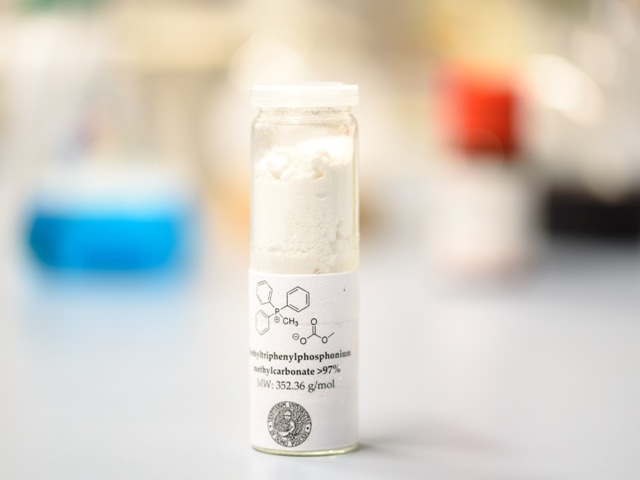Jun 10 2016
Ca’ Foscari has synthesized a molecule that is available to all laboratories worldwide. The “Perosa-Selva-Noè vinylation reagent” molecule, named after the Ca’ Foscari scientists who found it, is currently listed in the Sigma-Aldrich catalogue, a leading supplier of R&D chemicals in the world.
 The 'Perosa-Selva-Noè' reagent (ph- Andrea Avezzù/Ca' Foscari University)
The 'Perosa-Selva-Noè' reagent (ph- Andrea Avezzù/Ca' Foscari University)
The impressive outcome of “blue-sky” research conducted by the Green Chemistry group under the guidance of Alvise Perosa and Maurizio Selva, professors at the Department of Molecular Sciences and Nanosystems, is the named reagent, or molecule labeled after the names of its discoverers. This is any chemist’s ambition, not merely in terms of academic recognition. The reagent is currently available for purchase to global laboratories for a variety of applications.
All the aspects of this reagent are green, right from its production to its utilization.
It was identified during a curiosity-driven study into new methods of synthesizing ionic liquids, a fascinating class of green organic compounds. What makes it so interesting is its reactivity. Our molecule is capable of promoting a well-known organic reaction known as the Wittig vinylation in more environmentally compatible and extremely practical experimental conditions compared to analogous conventional commercial reagents.
Alvise Perosa, organic chemistry Professor at Ca’ Foscari
The Ca’ Foscari team found that this molecule has a number of hidden properties that surface out when it comes into contact with reagents of interest that can trigger the Wittig reaction. The researchers recognized the enormous application potential of this reaction since it is one among the most extensively diffused reactions in organic synthesis, and thus submitted it to Sigma-Aldrich immediately. Hence, the basic “blue-sky” research comes across applied research. The molecule developed in the labs of the Ca’ Foscari campus would be accessible to labs world-wide through the online catalogue of the company.
Methyltriphenylphosphonium methylcarbonate is the technical name of the new reagent. Its potential applications for organic syntheses have been explained in a scientific article in the ChemSusChem international journal by Wiley.
Marco Noè, PhD at Ca’ Foscari now a Marie Curie Fellow at the Institut Català d'Investigació Química (ICIQ, Spain) and Lisa Cattelan, a chemistry PhD student enrolled in the cotutelle programme between Ca’ Foscari-Trieste and Sydney University collaborated with Alvise Perosa and Maurizio Selva on this study.